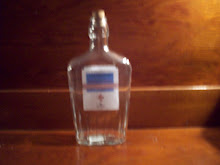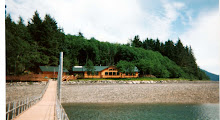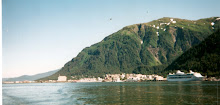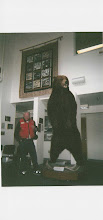Standing in the Million Dollar Golf Course at Juneau with some friends it was one of those days where I reminded myself how incredibly gorgeous Alaska is, fully made evident by a nearly cloudless day. We were a small group but all waiting for the event to happen.
The Million Dollar Golf Course is so named because really all it is is the mine tailings of the now closed gold mine at the base of Mount Juneau. Is is so named because the flat of land could still hold very small particles of gold if one had the means of extracting it and it was once actually a nine hole golf course set up for fun and mostly in jest. There are no grasses and no greens as such. The "greens" at each hole were compacted sand and evidently one could actually move a golf ball around through all that.
This day it was just a glorified land fill that afforded a good view of the top of Mount Juneau where we watched a helicopter land and unload a single person with his gear. Juneau is on a narrow strip of land framed by these two mountains, Roberts to the the south and Juneau to the north, at this time Roberts was beside us.
We could see the hang glider emerge on the very peak of Mount Juneau as the adventurer set it up. There was an agreed upon period of time in which if he didn't decide to go ahead with the glide the helicopter pilot would come back and pick him up. Understandably launching a hang-glider from the nearly 4000 foot peak could be too dangerous, not just from almost a mile of height but from unpredictable drafts of wind. If the takeoff were successful the whole flight probably would be.
After about fifteen minutes of waiting the daring individual leaped into the air and was off on a long thrilling ride that ended in a safe landing on the flats where we stood. This environment gets quite nasty in the winter months as over on the other side of Mount Roberts to our right is the Juneau Ice Field. The cold winds from this huge permanent plain of compacted ice, around 2000 to 2500 feet deep, has a habit of moving rapidly across the peak and dropping into the valley in high gusts of non-directional winds known as the Taku. This day the air was calm.
Taku is a popular Tlinket Indian name probably meaning something to the Tlinkets but I never knew what that is. A lot businesses in Juneau borrow the name and there is Taku this and Taku that throughout the area. The ice field spills out at its perimeter in various glaciers like the large Taku Glacier on the southeast border of the ice field and the Mendenhall Glacier north of Juneau.
I've estimated on a topographical map that the ice field is roughly 50 miles wide and 50 miles deep as it stretches across the border into Canada. It is said to cover 1500 square miles altogether. It is well studied by Dr. Maynard Miller, who teaches a class of Glaciologists there every summer. The group, now as much as 80 strong, marches in the Fourth of July Parade and then embarks on an eight week trek across the field as they take core samples and generally do what Glaciologists do.
I know of Dr. Miller as having been somewhat instrumental in the discovery of the major ecological issue of the hole in the ozone layer. Apparently the ice field has rings that demark time and weather going way back. There also is evidenced a cycle weather cycle that has been running full circle every 70 years like clockwork. When new core samples showed up a drastic change in that whereby the turnaround was an unheard of 35 years Dr. Miller was concerned to say the least.
As this little known story goes Dr Miller sent out communiques to his various comrades in the field about this including a Glaciologist researching in Antarctica. That scientist sent up a balloon and made a discovery of the hole in the ozone layer now having an effect on the global weather patterns. He got credit for the discovery but the string pull began with Maynard Miller.
Somewhere in the middle of the Juneau Ice Field, on the edge closer to the Canadian side of the ice field, is a set of mountain peaks known as Devil's Paw. Off to the side and to the northwest of Devil's Paw is a previously unnamed border peak that now carries the name Gisel Peak.
In honor of my Dad, Charles A. Gisel, Dr Miller took the effort to get the mountain named for his dangerous works in flying Glaciologists in not the safest of conditions as well as some dangerous rescue work in the helicopter. This took two submissions, being on the border. It had to get approval of the US government as well the Canadian government and Dr. Miller pushed it through both approval processes.
Gisel Peak is a very steep mountain crag that looks formidable to access. At some point it was charted and the height determined at 6,523 feet. Presumably that means it was once climbed by the USGS though I can't imagine this remote spire being at all sought out by the aspiring mountain climber set.
At one point I worked with Cinema Alaska, Inc. owned by Charles Mackey, a small film producer. During my time with the company we completed a short documentary film of a 15 minute plane ride over the Juneau Ice Field including some shots of Gisel
We were all proud of my father and having the mountain after him gave us all some satisfaction not, on my part, entirely satiating the unfulfilled desire to have known him better. It is there though, as a monument to his greatness.
[]












No comments:
Post a Comment